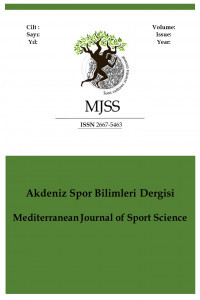Doping Amacıyla Sık Kullanılan İlaçların Biyokimyasal Etkileri
Biochemical Effects of Drugs Frequently Used for Doping Purposes
Doping, Drug, Biochemistry,
___
- Alsayari, A., Kopel, L., Ahmed, M. S., Pay, A., Carlson, T., ve Halaweish, F. T. (2017). Design, synthesis, and biological evaluation of steroidal analogs as estrogenic/anti-estrogenic agents. Steroids, 118, 32-40.
- Barkoukis, V., Lazuras, L., ve Harris, PR. (2015) The effects of self-affirmation manipulation on decision making about doping use in elite athletes. Psychol Sport Exerc, 16(175),81.
- Beyhan, Ö. (2018) Hormonlar. İstanbul: Nobel Tıp Kitapevleri.
- Çınar, V., Öztürk, M.E., ve Şebin, K. (2007). Doping ve sporcularda kullanımı/dopıng and usage. Beden Eğitimi ve Spor Bilimleri Dergisi, 9(3).
- Dalkara, S. (1992) Doping amacıyla kullanılan ilaçlar ve etkileri. İçinde: Hıncal, A., ve Dalkara, S. (Ed.), Anti doping eğitimi. Ankara: Hacettepe Üniversitesi.
- Dekhuijzen, P. N. R., Machiels, H. A., Heunks, L. M. A., Van der Heijden, H. F. M., ve Van Balkom, R. H. H. (1999). Athletes and doping: effects of drugs on the respiratory system. Thorax, 54(11), 1041-1046.
- Englund, J.L., ve William, P.K. (2013) Beta Blokerler. In: Tintinalli J E. (Ed)., Acil Tıp, 7. Baskı, İstanbul: Nobel Kitapevi
- Erdoğan, E. (2020). Sağlık boyutlarıyla doping, sağlık ve sosyal boyutlarıyla sporda doping, Ankara: Nobel akademi yayıncılık.
- Ertin, H., ve Bardakçı, T. (2020). Sporda İnsanı Geliştirme: Doping ve Dopingle Mücadelenin Tarihi. Turkiye Klinikleri Journal of Medical Ethics-Law and History, 28(1), 99-109. Faik, A. L. P. (1999). Doping. Etlik Veteriner Mikrobiyoloji Dergisi, 3(11-12), 86-93.
- Fanjul, A. N., Piedrafita, F. J., Al-Shamma, H., ve Pfahl, M. (1998). Apoptosis induction and potent antiestrogen receptor-negative breast cancer activity in vivo by a retinoid antagonist. Cancer research, 58(20), 4607-4610.
- Gündoğdu, C., Çelebi, E., Beyazçiçek, Ö., Beyazçiçek, E., Tüfekçi Ş., ve Özmerdivenli, Ş. (2017) Triatlon Atletlerinin Doping ve Anti-Doping Konusundaki Görüşlerinin Belirlenmesi. Konuralp Tıp Dergisi, 9 (63), 9
- Işık, S. (2015) Gelişim çağındaki basketbolcularda doping kullanımı eğilimi ve bilgi düzeyinin incelenmesi. Yayımlanmamış yüksek lisans tezi, Çanakkele Onsekiz Mart Üniversitesi Sağlık Bilimleri Enstitüsü, Çanakkale.
- Kerns, W.I., Kline, J, Ford, M.D. (1994). Beta-blocker and calcium channel toxicity. Emerg Med Clin North Am. 12(2), 365-90.
- Kindlundh, A. M., Isacson, D. G., Berglund, L., ve Nyberg, F. (1999). Factors associated with adolescent use of doping agents: anabolic‐androgenic steroids. Addiction, 94(4), 543-553.
- Morgan, T. O., Anderson, A. I., ve MacInnis, R. J. (2001). ACE inhibitors, beta-blockers, calcium blockers, and diuretics for the control of systolic hypertension. American journal of hypertension, 14(3), 241-247.
- Nagy, A. M., Meuris, S., ve Robyn, C. (1994). Origin and significance of the heterogeneity of protein hormones. Nuclear medicine and biology, 21(3), 317-330.
- Perez-Stable, E., ve Caralis, PV. (1983) Thiazide-induced disturbances in carbohydrate, lipid, and potassium metabolism. Am Heart J, 106, 245–51.
- Reardon, C.L., ve Creado, S. (2014). Drug abuse in athletes. Subst Abuse Rehabil. 5, 95-105.
- Salvetti, A., ve Ghiadoni, L. (2006) Thiazide diuretics in the treatment of hypertension: an update. Journal of the American Society of Nephrology, 17, 25–29.
- Saugy, M., Robinson, N., Saudan, C., Baume, N., Avois, L., ve Mangin, P. (2006). Human growth hormone doping in sport. British journal of sports medicine, 40(suppl 1), 35-39.
- Sjöqvist, F., Garle, M., ve Rane, A. (2008). Use of doping agents, particularly anabolic steroids, in sports and society. The Lancet, 371(9627), 1872-1882.
- Weidmann, P. (2001) Metabolic profile of indapamide sustained-release in patients with hypertension: data from three randomised double-blind studies. Drug Saf, 24, 1155–65.
- World Health Organization. (2020, 10 Ocak). Drugs. Erişim adresi: https://www.who.int/health-topics/drugs-psychoactive#tab=tab_1
- Vernec, A., Pipe, A., ve Slack, A. (2017). A painful dilemma? Analgesic use in sport and the role of anti-doping. Br J Sports Med, 51(17),1243-1244 Ünal, D.M., ve Durişehvar, Ü. (2003). Sporda doping kullanımı. İstanbul Tıp Fakültesi Dergisi, 66(3), 189-198.
- Yayın Aralığı: Yılda 4 Sayı
- Başlangıç: 2018
- Yayıncı: Hasan ŞAHAN
Futbol Hakemleri Açısından Seyirciyi Saldırganlığa Yönlendiren Faktörler
Şaban ÜNVER, Seydi Ahmet AĞAOĞLU, Büşra TÖREN
Kick Boks Sporcularının Sporcu Kimlikleri ile Sportmenlik Yönelimlerinin İncelenmesi
Vücut Ağırlığıyla Yapılan Kuvvet Antrenmanının Dinamik Dengeye Etkisi
Yunus BERK, Şaban ÜNVER, Mustafa BİNGÖL
Çocuk Sporcuların Rekreasyonel Egzersize Katılım Motivasyonu ve Mutluluk Düzeylerinin İncelenmesi
Melike ESENTAŞ DEVECİ, Özge YAVAŞ TEZ, Pınar GÜZEL GÜRBÜZ
Bocce Sporcularının Hedef Yönelimlerinin Spora Bağlılıkları Üzerindeki Rolü: Çanakkale İli Örneği
Ender Ali ULUÇ, Fahri AKÇAKOYUN
Ragbi Sporcularında Duygusal Zekâ ve Kişilik Özellikleri Arasındaki İlişkinin İncelenmesi
Aydıner Birsin YILDIZ, Duygu BÜLBÜL, Gözde ALGÜN DOĞU
Doping Amacıyla Sık Kullanılan İlaçların Biyokimyasal Etkileri
3X3 Basketbol İle 5'e 5 Basketbolun Oyun İçi İstatistiklerinin Analizi
